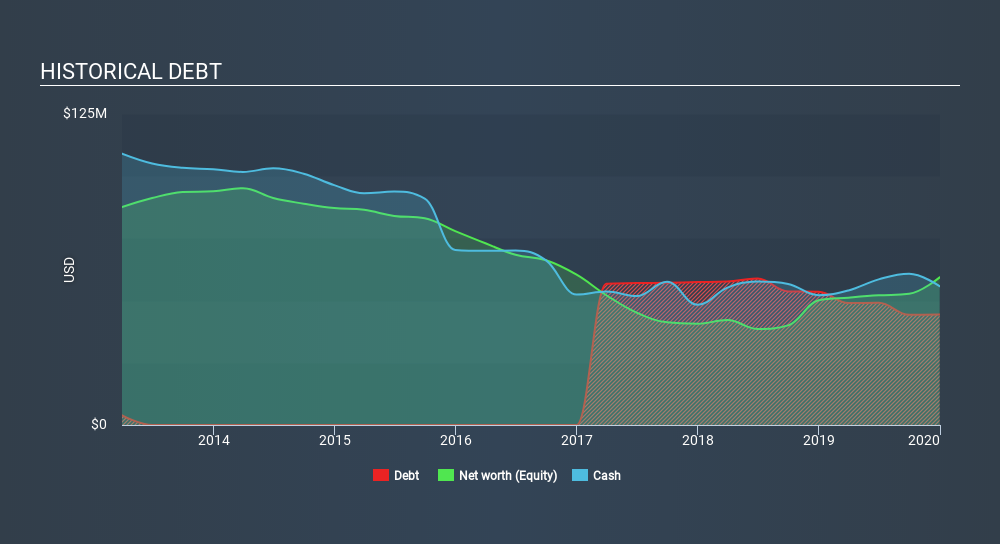
Legendary fund manager Li Lu (who Charlie Munger backed) once said, 'The biggest investment risk is not the volatility of prices, but whether you will suffer a permanent loss of capital. It's only natural to consider a company's balance sheet when you examine how risky it is, since debt is often involved when a business collapses. We can see that Model N, Inc. (NYSE:MODN) does use debt in its business. But the real question is whether this debt is making the company risky.
What Risk Does Debt Bring?
Debt assists a business until the business has trouble paying it off, either with new capital or with free cash flow. Ultimately, if the company can't fulfill its legal obligations to repay debt, shareholders could walk away with nothing. While that is not too common, we often do see indebted companies permanently diluting shareholders because lenders force them to raise capital at a distressed price. By replacing dilution, though, debt can be an extremely good tool for businesses that need capital to invest in growth at high rates of return. The first step when considering a company's debt levels is to consider its cash and debt together.
Check out our latest analysis for Model N
What Is Model N's Debt?
You can click the graphic below for the historical numbers, but it shows that Model N had US$44.4m of debt in December 2019, down from US$53.6m, one year before. However, its balance sheet shows it holds US$55.8m in cash, so it actually has US$11.4m net cash.

A Look At Model N's Liabilities
We can see from the most recent balance sheet that Model N had liabilities of US$70.7m falling due within a year, and liabilities of US$43.8m due beyond that. On the other hand, it had cash of US$55.8m and US$31.1m worth of receivables due within a year. So its liabilities total US$27.6m more than the combination of its cash and short-term receivables.
Of course, Model N has a market capitalization of US$1.04b, so these liabilities are probably manageable. However, we do think it is worth keeping an eye on its balance sheet strength, as it may change over time. Despite its noteworthy liabilities, Model N boasts net cash, so it's fair to say it does not have a heavy debt load! When analysing debt levels, the balance sheet is the obvious place to start. But ultimately the future profitability of the business will decide if Model N can strengthen its balance sheet over time. So if you want to see what the professionals think, you might find this free report on analyst profit forecasts to be interesting.
Over 12 months, Model N made a loss at the EBIT level, and saw its revenue drop to US$145m, which is a fall of 4.0%. That's not what we would hope to see.
So How Risky Is Model N?
While Model N lost money on an earnings before interest and tax (EBIT) level, it actually generated positive free cash flow US$9.6m. So although it is loss-making, it doesn't seem to have too much near-term balance sheet risk, keeping in mind the net cash. Until we see some positive EBIT, we're a bit cautious of the stock, not least because of the rather modest revenue growth. When analysing debt levels, the balance sheet is the obvious place to start. However, not all investment risk resides within the balance sheet - far from it. For instance, we've identified 2 warning signs for Model N that you should be aware of.
If you're interested in investing in businesses that can grow profits without the burden of debt, then check out this free list of growing businesses that have net cash on the balance sheet.
If you spot an error that warrants correction, please contact the editor at editorial-team@simplywallst.com. This article by Simply Wall St is general in nature. It does not constitute a recommendation to buy or sell any stock, and does not take account of your objectives, or your financial situation. Simply Wall St has no position in the stocks mentioned.
We aim to bring you long-term focused research analysis driven by fundamental data. Note that our analysis may not factor in the latest price-sensitive company announcements or qualitative material. Thank you for reading.
About NYSE:MODN
Model N
Provides cloud revenue management solutions for life sciences and high-tech companies in the United States and internationally.
High growth potential with adequate balance sheet.
Similar Companies
Market Insights
Community Narratives





